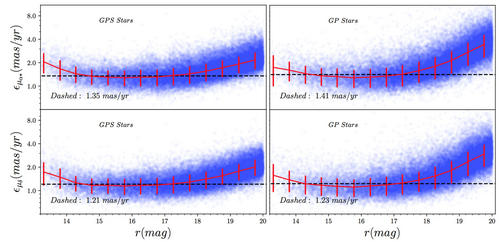An international team led by Dr. Haijun Tian of China Three Gorges University (CTGU) and Chao Liu of National Astronomical Observatories of China (NAOC) combine Gaia DR1, PS1, SDSS and 2MASS astrometry to construct a catalog of proper motions(dubbed GPS1)consist of~350 million sources across three-fourths of the sky down to a magnitude of mr<20.GPS1 has a characteristic systematic error of less than 0.3 mas/yr, and a typical precision of 1.5-2.0mas/yr. The proper motions have been validated using galaxies, open clusters, distant giant stars and QSOs. In comparison with other published faint proper motion catalogs, GPS1's systematic error (<0.3 mas/yr) should be nearly an order of magnitude better than that of PPMXL and UCAC4 (>2.0 mas/yr). Similarly, its precision (~1.5mas/yr) is a four-fold improvement relative to PPMXL and UCAC4 (~6.0mas/yr).This work has been published online in the Astrophysical Journal Supplement Series(ApJS, 232, 4T, 2017).
In the recent decades, several high-precision and large photometric surveys have been completed or are being carried out in the world. The time baseline is from 2000 to 2015. It provides an unprecedented opportunity to build the best current proper motion catalog across much of the sky. After the first 14 months of observation, the ESA mission Gaia published its first data release (Gaia DR1) on September 14, 2016. It consists of around 1.14 billion astrometrical sourceswithhigh accurateposition coordinatesin J2015.0. The average positional uncertaintyof the sources with G<20 magis better than 16.6 mas. After more than 5 years survey, thePan-STARRS (PS1) has collected multi-detection positions forbillions starsacross three-fourths of the sky, with average positionaluncertaintyof~15 mas. The SDSS and 2MASS released the photometric data 10~20 years ago, with positional accuracies of 25 mas and 100 mas, respectively. Dr. Hai-Jun Tian obtained the permission to use these data during his MPIA visit in 2016, and rapidly complete theconstruction of GPS1.
The proper motion catalog GPS1, particularly combined with LAMOST, provides vital information for understanding the stellar kinematics, the dynamic mechanism, and revealing the origin and evolutionary history of the Milky Way. As the reviewer's comments: GPS1 has the potential to be a valuable asset to the community until (and perhaps beyond) the Gaia DR2 release.
Dr. Branimir Sesarand, Prof. Hans-Walter Rix at MPIA have contributed to this work as key co-authors. The work was supported by the National Natural Science Foundation of China (NSFC) and the fellowships from China Scholarship Council (CSC) and Max Planck Institute for Astronomy (MPIA).


The distribution ofGPS1proper motion uncertainties for stars with 14<mr<18 in the equatorial Mollweide projection maps (top) and the variation of the proper motion precisions with the magnitude (bottom)

Address: 20A Datun Road, Chaoyang District, Beijing, China code: 100012
Tel: 010-64888708 E-mail: naoc@nao.cas.cn

